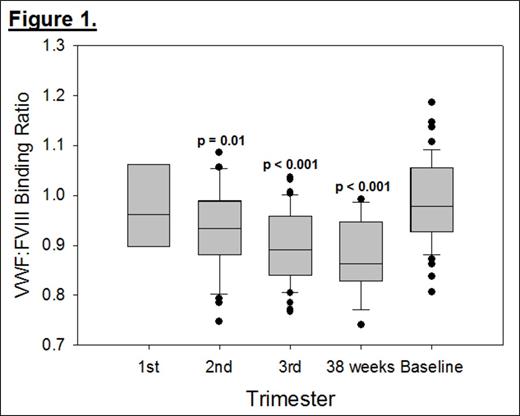Abstract
Background: The coagulation protein von Willebrand Factor (VWF) and its circulating partner protein, Factor VIII, are known to be elevated in pregnancy. However, the nature of changes in VWF which occur during pregnancy are not well understood. We previously presented results from a study of 46 healthy pregnancies in which we measured VWF antigen (VWF:Ag) and Factor VIII (FVIII determined both by activity and antigen measurements). We found that VWF:Ag and FVIII increased during pregnancy, consistent with less FVIII relative to VWF. We have also observed that VWF multimer size can decrease during pregnancy. We hypothesized that pregnancy can induced molecular changes in VWF, and that such changes could impact the interaction of VWF with its ligands, specifically FVIII.
Methods: We adapted a Type 2N von Willebrand Disease (VWD) assay to test the ability of plasma VWF to bind recombinant FVIII. In brief, serial dilutions of plasma VWF were captured using a polyclonal anti-VWF antibody (DAKO), endogenous FVIII was stripped using a CaCl2 wash, recombinant FVIII (Recombinate) was applied, and bound FVIII was detected using an anti-FVIII antibody (Cedarlane). In parallel, a VWF:Ag ELISA was performed using the same anti-VWF capture antibody. The VWF-FVIII binding ratio (VWF-FVIIIb) was then determined by dividing the quantity of rFVIII detected by the amount of VWF:Ag immobilized on the plate. The range, reproducibility, and variance of the assay was first determined in a healthy blood donor repository. We then tested VWF-FVIIIb in healthy pregnancies for which 3rd trimester and non-pregnant baseline samples were available. Additional time points during pregnancy were also studied, when available. VWF-FVIIIb results for each trimester and the non-pregnant baseline were analyzed by one-way ANOVA (All Pairwise Multiple Comparison Procedures, Holm-Sidak method).
Results: Forty-six healthy pregnancies with non-pregnant baseline samples were studied. Samples tested were drawn in the first (n=6), second (n=38), and third (n=43) trimesters, at 38 weeks gestational age (n=13), and at a non-pregnant time point (baseline). In non-pregnant samples, the VWF-FVIIIb was close to 1.0 (0.988 +/- 0.084), similar to a normal blood donor repository. We identified a significant decrease in VWF-FVIIIb in the second trimester (0.931 +/- 0.82; p = 0.013), which became more pronounced in the third trimester (0.899 +/- 0.75; p < 0.001) and at 38 weeks gestational age (0.88 +/- 0.072; p < 0.001). The means, quartiles, and standard deviations for each pregnancy time point are shown in Figure 1.
Conclusions: These data support the hypothesis that VWF can acquire a decreased ability to interact with FVIII during pregnancy. A decreased capacity to carry FVIII could contribute to the increased VWF:FVIII ratio we and others have observed during pregnancy, although other factors, such as increased VWF production relative to FVIII, could also play a role. This work provides further evidence for a new model of acquired VWF changes in the setting of pregnancy.
No relevant conflicts of interest to declare.
Author notes
Asterisk with author names denotes non-ASH members.


This feature is available to Subscribers Only
Sign In or Create an Account Close Modal